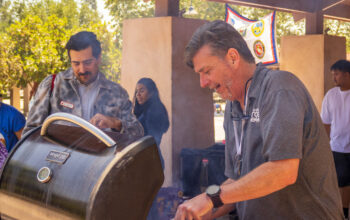Every fall semester for the last six years, Associate Professor of Architecture Beth Abels takes a group of students on a trek from one end of the Los Angeles River to the other.
This select group of architecture students go on the trip as part of a design studio course of the river. The course involves researching and touring the river, and leads up to eventually drafting centers to mark headwaters.
“In this city, there’s maybe a thousand people who know a lot about the river, and Pierce architecture students are 40 of those thousand people,” she said. “I think that’s so cool. I love that.”
A practicing architect, Abels received her first taste of working as an educator right after she had her first child. At the time, she was volunteering at an elementary school.
“It wasn’t like I was thinking, ‘Oh, I should be a professor.’ It kinda just happened,” she said. “I found I really liked it.”
Abels, who has been working in education for 18 years, has experience teaching part time at Pasadena City College and Santa Monica College. She discovered the job opening for Pierce College’s architecture program through a Craigslist ad, and, when accepted, started in 2008.
“I thought it might be fun to teach full time and I was ready for a change from my practice anyway, so it seemed like a good switch,” she said.
Because of her heavy workload as the only full-time architecture professor at Pierce, she has been forced to take on less building projects. She plans on getting her practice up and running again in the next year.
“I feel like I’ve been at Pierce long enough that our program is running relatively smoothly, so I feel like I’m going to have more time to do my architecture on the side,” Abels said. “I think it’s better for students if I’m practicing so they can see that side of the profession.”
She credits her passion for architecture to her affinity for art and desire for social justice, a trait that she inherited from her activist parents.
“As a young person, I never really felt like art was going to satisfy that for me, that sort of desire to be an asset for the community,” Abels said. “[Architecture] seemed like it could fulfill the art side of me–the sculptural side and the drawing side and creative side–and also the need-to-provide-service-to-the-community side.”
In turn, she passes this zeal along to her students by going the extra mile as a professor with the LA River-centric class.
“The LA River’s been ignored pretty well,” she said. “It can be this fabulous asset for us as a city.”
This fact has stuck with architecture major Juan Becerril, 21, who took the class with Abels during fall 2013.
“A lot of people look at the LA River like it’s a giant water drain,” he said.
Through the course, she’s able to teach her students the importance of relating the area they are in to the surrounding places, as well as the city as a whole.
“For architecture education, it’s very important to understand what the layers are and how things are connected,” Abels said. “Almost like when you think about the structure of a body, with the veins and arteries and flesh and bone, cities are like that.”
Abels says that while the LA River has been more accessible these days because of ongoing resurgence, in the past there have been areas that were closed off to the public.
“I’m careful. I don’t take my students to those places, but there are places where you think you’re going in and you find out you’re not supposed to be there,” she said. “We’ve been pretty lucky.”
She says that although none of the students who have taken the class have moved on to work directly with the LA River, they have been able to incorporate what they’ve learned into their next career or educational choice.
“Many of my students have transferred to architecture programs where their expertise with the LA River is what made them a desirable candidate,” she said. “I have a lot of student who are becoming experts in sustainability, and that expertise comes from their developing this understanding of how water systems work.”
The class also personally impacts the students who take it.
“Working it out on our project, we had to look at it from an environmentalist point of view and residents’ point of view,” Becerril said. “In everything in life you have to look at different angles.
Abels hopes to take the class even further by involving her students in active change, not just in-class practices.
“Every studio is different, and every student group is different,” she said. “My next hope is that we start working with people who are actually going to be decision makers and that they start to work with these students and see what [they] can offer,” she said. “My students certainly have that capacity.”



